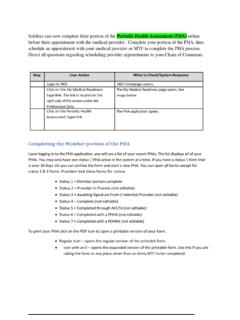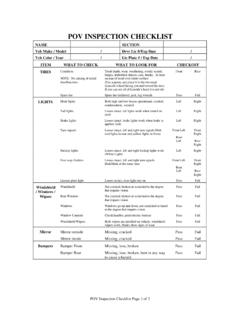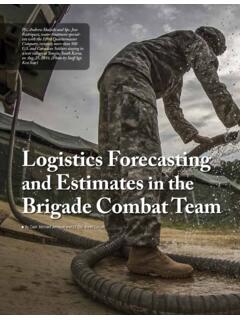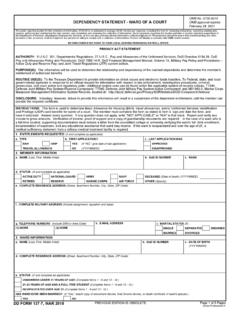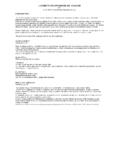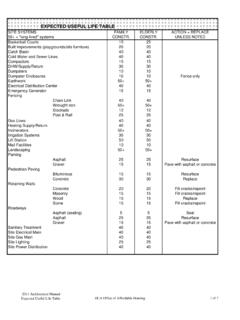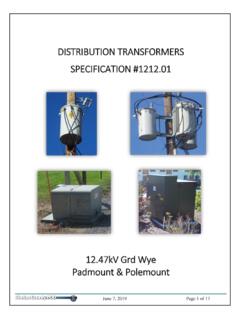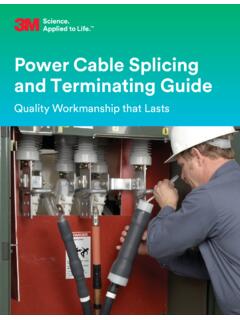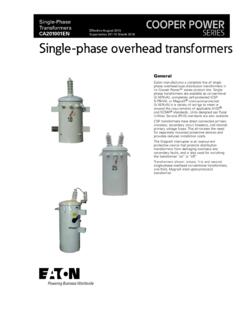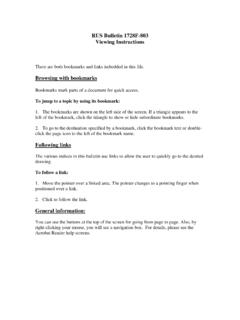Transcription of Compressed Gas Safety General Safety Guidelines
1 Compressed Gas Safety General Safety Guidelines Occupational Safety & Health Bureau Montana Department of Labor & Industry Prepared for Montana Employers by the Occupational Safety & Health Bureau Department of Labor and Industry Box 1728. Helena, Montana 59624-1728. (406) 444-6401. Compressed Gas General Introduction Compressed gas cylinders can be extremely hazardous when misused or abused. Compressed gas cylinders can present a variety of hazards due to their pressure and/or content. Depending on the particular gas, there is a potential for simultaneous exposure to both mechanical and chemical hazards. Gases used maybe: Flammable or Inert combustible Acidic Corrosive Reactive Explosive or a combination Poisonous of hazards Without proper use and care Compressed gas cylinders can explode killing workers and destroying equipment.
2 Cylinders can also become flying projectiles when cylinder valves are damaged or broken off. Regulators can become bullets that tear through workers if Safety precautions are not taken. Careful procedures are necessary for handling the various Compressed gases, cylinders, regulators or valves used to control gas flow, and the piping used to confine gases during flow. This booklet can be used as a guideline for the safe use of Compressed gas. Regulations Applicable to Compressed Gas Containers A. Compressed gases. Compressed Gas Association Pamphlet P-1-1965, covers in- plant handling, storage, and use of all Compressed gas cylinders, portable tanks, or motor vehicle cargo.
3 B. Inspection of Compressed gas cylinders. Each employer must determine that Compressed gas cylinders under his/her control are in a safe working condition to the extent that can be determined by a visual inspection. Visual and other inspections must be conducted as prescribed in the Hazardous Materials Regulations of the Department of Transportation (49 CFR parts 171-179 and 14 CFR part 103). Where those regulations are not applicable, visual and other inspections shall be conducted in accordance with Compressed Gas Association Pamphlets C-6-1968 and C- 8-1962. 2. C. Safety relief devices for Compressed gas containers.
4 Compressed gas cylinders, portable tanks, and cargo tanks shall have pressure relief devices installed and maintained in accordance with Compressed Gas Association Pamphlets (CGA) and 1965. addenda and D. Welding and cutting. The storage, handling, and use of Compressed gas containers for welding and cutting shall comply with the American National Standards Institute ANSI and 29 CFR E. National Fire Prevention Association. NFPA 55, Standard for the Storage, Use, and Handling of Compressed and Liquefied Gases in Portable Cylinders. Checklist A is intended to assist you in identifying possible Safety and health hazards concerning Compressed gas cylinders for General use.
5 Following each check is the reference number to the CGA Pamphlet P-1 1974 (see appendix A). Checklist B is intended to assist you in identifying possible Safety and health hazards concerning installation and operations of oxygen and fuel/gas systems for welding and cutting. Following each check is the reference number for 1969 (see appendix B). I. Compressed Gas Safety Guidelines A. Identification ALWAYS READ THE LABEL . The contents of any Compressed gas cylinder must be clearly identified. Gas identification should be stenciled or stamped on the cylinder or a label. Commercially available three-part tag systems may be used for identification and inventory.
6 No Compressed gas cylinder should be accepted for use that does not legibly identify its contents by name. If the labeling on a cylinder becomes unclear the cylinder should be marked contents unknown and returned to the supplier. Do not rely on the color of the cylinder for identification. Color-coding is not reliable because cylinder colors may vary with supplier. Also, never rely on labels on caps because they are interchangeable. All gas lines leading from a Compressed gas supply should be clearly labeled to identify the gas and the area served. The labels should be coded to distinguish hazardous gases such as flammable, toxic, or corrosive substances.
7 Signs should be posted in areas where flammable Compressed gases are stored or used, identifying the substance and appropriate precautions. 3. B. Handling and Use 1. Before cylinders are first used the following precautions should be taken: Make sure the cylinder is equipped with the correct regulator. Inspect the regulator and cylinder valves for grease, oil, dirt, and solvent. Never use grease or oil to lubricate regulators or cylinder valves because they can cause an explosion. The cylinder should be placed so that the valve handle at the top is easily accessible. When using toxic or irritating gas, the valve should only be opened while the cylinder is in a working fume hood.
8 Only use wrenches or tools that are provided by the cylinder supplier to open or close a valve. Pliers should never be used to open a cylinder valve. Some regulators require washers; this should be checked before the regulator is fitted. Refer to MSDS for the gas being used for information regarding use and toxicity. Fire extinguishing equipment should be readily available when combustible materials can be exposed to welding or cutting operations using Compressed cylinder gases. 2. Cylinder Storage Gas cylinders must be secured at all times to prevent tipping. Use appropriate material, such as chain, plastic coated wire cable, commercial straps, etc.
9 , to secure cylinders. Gas cylinders can not be stored in public hallways or other unprotected areas. Cylinders must be segregated in hazard classes while in storage. Oxidizers (oxygen). must be separated from flammable gases, and empty cylinders must be isolated from filled cylinders. The proper storage for oxygen cylinders requires that a minimum of 20 feet is maintained between flammable gas cylinders and oxygen cylinders or the storage area be separated, at a minimum, by a firewall five (5) feet high with a fire rating of 30. minutes. 4. Store out of direct sunlight and away from sources of heat and ignition; temperatures must not exceed 125 F.
10 Acetylene cylinders must never be stored on their sides. Always place valve protectors on gas cylinders when the cylinders are not connected for use. Cylinders must be protected from damage. Do not store cylinders near elevators or gangways, or in locations where heavy-moving objects may strike or fall on them. Cylinders must be stored where they are protected from the ground to prevent rusting. Cylinders should be protected against tampering by unauthorized individuals. Storage areas must be well-ventilated, cool, dry, and free from corrosive materials. 3. Moving Cylinders Never drag, slide or roll a cylinder; use a cylinder cart or basket.
